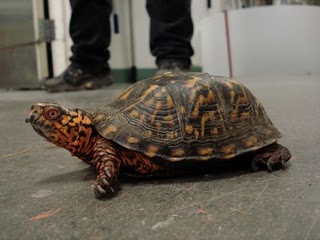Donald is another of our education animals that lives behind the scenes. He came to us in March of 2004, and was brought in by one of the animal keepers. The animal keeper had acquired him from one of our volunteers at the time, who had found him injured in the road after being grazed by a car. When first found, one of Donald’s legs was injured and his shell was damaged, and the volunteer thought he was dead. However, after some time and good care, he made a full recovery and is now a great program animal. Although there was noticeable trauma to his shell at first, it now suprisingly looks normal except for a few small scarred areas!
Below is a picture of Donald’s shell. If you look closely, you can see an area on his right side as well as a line down the middle of his shell that is lighter in color than his other markings. Those are the scars.

Unfortunately, being hit by cars is one of the biggest causes of death for many species of wildlife. All of us at one time or another have passed a deer, opossum, snake, skunk, raccoon, turtle, frog, fox or owl on the side of the road that lost its life because of a car. I even passed a black bear that had been struck once when I was driving back from the east coast. It’s also one of the most frequent causes of death for the wild red wolf population in eastern North Carolina! The sheer volume of these accurances means that car injuries are a fairly common way that we acquire our animals. Many times, if an animal survives the original trauma, it never recovers enough from its injuries to be released back to the wild. We feel that they can serve a good purpose by educating others about the importance of wildlife, while also receiving a good home with lots of loving care from the museum keepers, staff and visitors.
Although we have 3 other box turtles available for public programs, Donald is probably the most popular amongst the educators. He is not only valuable in teaching people to be more cautious of animals on the road, but he is well socialized so he does not hide in his shell like most box turtles instinctively do.
We are not sure of Donald’s age, other than the fact that he is over 15 years old. But the average lifespan for a box turtle in captivity is typically 25-30, although they’ve been known to live up to 50 years. Eastern box turtles are omnivores, and are known to eat virtually anything in the wild including insects, fruits and berries, snails, earthworms, plant matter, grasses and flowers, mushrooms and carrion. At the museum, our box turtles have one of the most diverse diets of any of our species! Although Donald will eat his fruits and vegetables, there is no doubt he prefers his meat over anything else. Some of the meat items that he gets are crickets, snails, mouse pinkies, cooked shrimp and mealworms.
Below is a video of Donald eating a superworm, which was recorded for our “Munch Cam” series. We have several other fun Munch Cam videos of our animals chowing down, and you can see them all by clicking here.
[youtube=http://www.youtube.com/watch?v=Lhw_nIYiqHs]
The information in this post, along with many more interesting facts about eastern box turtles, can be found at http://en.wikipedia.org/wiki/Eastern_Box_Turtle and http://www.bio.davidson.edu/people/midorcas/research/Contribute/box%20turtle/boxinfo.htm

hes a very dainty eateri think he follows the raw diet for the most part
mouse pinkies?!?
Is he named for our volunteer Donald?